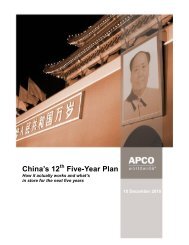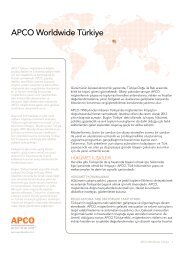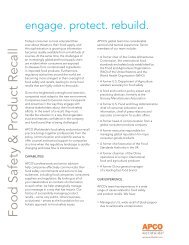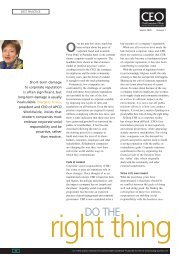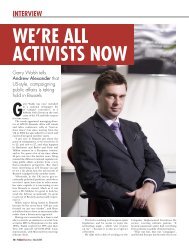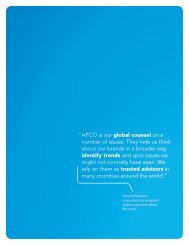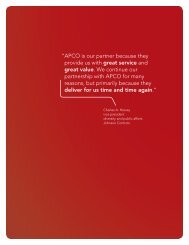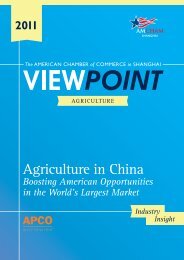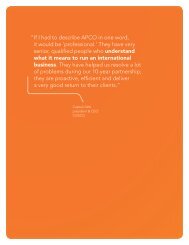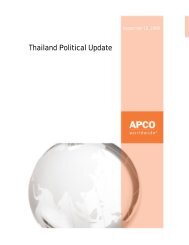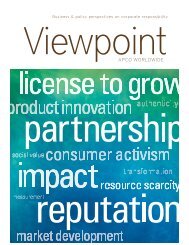China's 2011 National People's Congress (NPC): - APCO Worldwide
China's 2011 National People's Congress (NPC): - APCO Worldwide
China's 2011 National People's Congress (NPC): - APCO Worldwide
Create successful ePaper yourself
Turn your PDF publications into a flip-book with our unique Google optimized e-Paper software.
China’s <strong>2011</strong> <strong>National</strong><br />
People’s <strong>Congress</strong> (<strong>NPC</strong>):<br />
Fine-tuning the economy with an eye<br />
on social stability<br />
March <strong>2011</strong>
EXECUTIVE SUMMARY<br />
� The approval of China’s 12 th Five Year Plan (FYP) was the highlight of this year’s<br />
meeting of China’s parliament – the <strong>National</strong> People’s <strong>Congress</strong> (<strong>NPC</strong>). Covering the<br />
years <strong>2011</strong>-2015, the 12 th FYP sets out to rebalance the economy with a strong<br />
emphasis on increasing consumption, narrowing China’s growing income gap, promoting<br />
environmental protection and energy efficiency initiatives, and boosting strategic<br />
industries.<br />
� Passage of the plan had added significance given the approaching leadership transition<br />
in 2012/2013. The 12 th FYP is part of President Hu Jintao’s political legacy and China’s<br />
new leaders will inherit the economic and social priorities defined in the plan.<br />
� The <strong>NPC</strong> meeting occurred against a backdrop of concerns about domestic inflation,<br />
high property prices, and popular uprisings in the Middle East. Not surprisingly, this<br />
<strong>NPC</strong> session focused on policies to improve the livelihood of Chinese citizens and<br />
control social dissent. Key initiatives included measures to tackle China’s rapidly rising<br />
food and housing prices, increases in the budget for social welfare and greater internal<br />
security spending.<br />
� In addition, this year’s <strong>NPC</strong> saw a few officials taking turns in the media spotlight,<br />
underscoring the growing role of public relations in Chinese politics. There was jockeying<br />
between China’s established Tuanpai and Shanghai political factions and the emerging<br />
Princeling group. Wen Jiabao and Wu Bangguo delivered what appeared to be opposing<br />
statements regarding political reform, but a closer look suggests that the Party has no<br />
plans for political reform as defined by most foreign observers. Rather, the Party<br />
remains determined to maintain its absolute control.<br />
� The upcoming change in leadership should not significantly change China’s business<br />
environment in the short term. New administrations in China are generally constrained in<br />
their ability to undertake any serious political reforms, and Xi Jinping has already<br />
indicated his intent to follow the policies as laid out by Hu and Wen’s 12 th FYP.<br />
� A shift to consumption-led growth will have a profound impact on foreign business in the<br />
long term as Chinese consumerism rises. In the short term, however, Foreign Invested<br />
Enterprises (FIEs) will face increased costs from social welfare measures and<br />
government mandated increases in minimum wages.<br />
INTRODUCTION & BACKGROUND<br />
PUTTING THE <strong>NPC</strong> IN CONTEXT<br />
With ritual regularity, the <strong>National</strong> People’s <strong>Congress</strong> (<strong>NPC</strong>) and the Chinese People’s Political<br />
Consultative Conference (CPPCC) convene each March in Beijing for a two-week session. The<br />
meeting draws together nearly 3,000 delegates from around the country. In theory, the <strong>NPC</strong> is<br />
China’s highest and most powerful organ of state power, and this gathering marks one of the<br />
most important events in the Chinese political calendar.<br />
In practice, however, the <strong>NPC</strong>’s yearly gathering is largely an exercise in legislative<br />
acquiescence, with delegates approving appointments, laws and ministerial work reports<br />
predetermined by the Communist Party of China (CPC)—hence the gathering’s reputation as<br />
China’s ‖rubber stamp legislature.‖ The control exercised by the Party over <strong>NPC</strong> proceedings is<br />
1
owed mostly to the political allegiance of the delegates themselves—more than 70 percent of<br />
the <strong>NPC</strong>’s deputies are Party members (they are only 6 percent of the total population), and all<br />
are tacitly approved by the Party.<br />
This year’s <strong>NPC</strong> (held March 5-14) came at an interesting juncture—the first year of China’s<br />
Twelfth Five Year Plan and the last full year of the Hu-Wen administration. This, however, is no<br />
lame duck administration. Hu and Wen have presented measures that are fully geared towards<br />
improving, and controlling, the lives of Chinese citizens. Against this backdrop, the <strong>NPC</strong><br />
meeting serves as a useful snapshot or temperature check on China’s political economy and<br />
how it is being managed.<br />
KEY FEATURES OF THE <strong>NPC</strong><br />
The highlight of each session is<br />
the opening remarks delivered<br />
by the State Council premier<br />
and China’s top economic<br />
planner, Wen Jiabao. Often<br />
compared to a ―state of the<br />
union‖ address, the Premier’s<br />
―work report‖ speech is one of<br />
the few times each year that a<br />
top leader provides an overview<br />
of the government’s political,<br />
social and economic priorities,<br />
and it is analyzed carefully as a<br />
rare window into Party thinking.<br />
Key elements of this year’s<br />
work report are summarized in<br />
the table to the right. At the end<br />
of each <strong>NPC</strong>, the premier holds<br />
a press conference. This is<br />
usually the premier’s only such<br />
press conference each year,<br />
and his remarks are also<br />
subject to close scrutiny.<br />
In another example of the fast pace of economic and social change in China, there was much<br />
media attention this year on the sheer number of billionaire delegates in both the <strong>NPC</strong> and<br />
CPPCC. A Hurun Report on China’s wealthy noted that the richest 70 delegates had a<br />
combined wealth of about USD 75 billion, compared with USD 4.8 billion for the wealthiest 70<br />
members of U.S. <strong>Congress</strong>. The <strong>NPC</strong> and CPPCC, once a gathering of working-class<br />
comrades, are quickly becoming a home for Chinese elites, perhaps resulting in an uptick in<br />
importance for these two congresses as they develop into a business and networking forum just<br />
as much as a political event.<br />
2
RAISING LIVING STANDARDS A TOP PRIORITY<br />
“Now we want to put more emphasis on ensuring and improving people’s livelihood.”<br />
– Zhang Ping, NDRC Director, March 5, <strong>2011</strong><br />
THE TWELFTH FIVE-YEAR PLAN<br />
Wen Jiabao unveiled the government’s 12 th FYP for <strong>National</strong> Economic and Social<br />
Development (<strong>2011</strong>-2015) at this year’s <strong>NPC</strong>, which delegates dutifully ratified with 2,778 in<br />
favor, 59 against and 38 abstentions. The 12 th FYP is a bold initiative – it emphasizes the<br />
quality, rather than the quantity, of growth, and it strives to ensure that more Chinese citizens<br />
benefit from the country’s unprecedented development.<br />
Not surprisingly, Hu and Wen are seeking to use the 12 th FYP to bed down their legacy as the<br />
first leadership team in the post-reform era with a strong focus on equality issues. Under Hu and<br />
Wen’s ―harmonious society‖ and ―scientific development concept‖ policy frameworks, the 12 th<br />
FYP will continue the 11 th FYP’s focus on moving away from ―growth at any cost‖ and toward a<br />
more balanced and sustainable growth pattern. Unlike the 11 th FYP, however, the development<br />
of the 12 th FYP took place in a markedly different internal and external environment: the global<br />
financial crisis and increased risk of social instability are all salient issues in China that are<br />
prominently addressed by this plan.<br />
Implementing the initiatives of the 12 th FYP will also ensure policy continuity during the<br />
upcoming leadership transition in 2012-2013, when President Hu and Premier Wen are<br />
expected to be replaced by Xi Jinping and Li Keqiang. Xi publically stated that he intends to<br />
follow Hu and Wen’s policy initiatives throughout the entire 12 th FYP period.<br />
RESTRUCTURING THE ECONOMY<br />
Restructuring the economy is the principal objective of the 12 th FYP. Changing the country’s<br />
growth model is a critical concern for Chinese decision-makers for several reasons. First, the<br />
sharp decrease in Chinese exports during the financial crisis, leading to the layoff of millions of<br />
factory workers, underscored the importance for Chinese decision-makers of moving to a more<br />
balanced growth structure. Second, large global trade and foreign exchange imbalances have<br />
led to tensions between China and its major trading partners. Third, China suffers from the<br />
inefficient use of resources and extreme environmental degradation that accompanies high<br />
levels of Fixed Asset Investment (FAI). However, perhaps the most critical reason why the<br />
Chinese government is pushing for bold economic reform is the perceived threat of social<br />
instability that can grow out of China’s rapidly rising income disparity.<br />
While the Chinese government has usually fared well with economic initiatives focused on<br />
splashing large sums of money around, the sheer size of China’s economy, coupled with<br />
various entrenched interests to keep things as is, has meant that making a major shift in China’s<br />
growth model is actually quite difficult – the 10 th and 11 th FYPs also called for similar economic<br />
reforms, to no avail. Nevertheless, if the government is serious about substantive change, like<br />
the opening up of the late 1970s and the marketization reforms of the late 1990s, the 12 th FYP<br />
may well be remembered as one of the most significant such plans in modern China’s history.<br />
The 12 th FYP aims to fundamentally restructure the economy through four primary initiatives:<br />
lowering economic growth targets, increasing consumption, implementing energy savings and<br />
environmental protection measures, and promoting strategic industries.<br />
3
Slowing down growth: Wen Jiabao announced that China’s GDP growth target for the 12 th<br />
FYP plan period is 7 percent, down from the 11 th FYP’s goal of 7.5 percent. This largely<br />
symbolic goal (the 11 th FYP period averaged a growth rate of more than 11 percent, and Wen<br />
announced a GDP growth target of 8 percent for <strong>2011</strong> in his work report) indicates that the<br />
central government is aiming to reduce its focus on FAI as a growth driver and provide some<br />
breathing space to set policies that will slowly increase consumption. As central-level and locallevel<br />
objectives are difficult to align, enforcement of this goal will be problematic – only two of<br />
China’s provinces, Beijing and Shanghai, have announced growth goals that are closer to the<br />
lower 7 percent target, with several provinces having already announced targets of 13 percent<br />
and higher.<br />
Increasing consumption: Wen’s work<br />
report called expanding domestic demand ―a<br />
long-term strategic principle.‖ Increasing<br />
consumption might prove to be a difficult task<br />
– China has enjoyed spectacular growth<br />
from its old growth model; a model that<br />
promoted investments and exports at the<br />
expense of increased wage growth and<br />
household savings. While a small proportion<br />
of individuals in China have become<br />
extremely wealthy as a result, the income of<br />
many citizens has not kept pace with<br />
economic growth over the past decade. The 12 th FYP aims to increase household disposable<br />
income by an annual rate of 7 percent, the same as the projected GDP growth rate during the<br />
FYP period. Specific policy measures to increase income include raising minimum wages (the<br />
Beijing government has announced its plan to increase minimum wages by 40 percent by 2015,<br />
for example), personal income tax reform (raising income tax brackets so low-to-middle incomes<br />
are taxed less) and improved rural land distribution.<br />
Another policy tool to promote consumption is the expansion of government-funded social<br />
welfare initiatives. The government announced at the <strong>NPC</strong> its intent to increase health care<br />
spending by 25 percent more than originally planned, build 36 million affordable homes at a cost<br />
of nearly USD 200 billion and ensure its pension system covers all rural citizens by 2015.<br />
Increasing the rate of urbanization, partially through reforming the rigid and outmoded<br />
household registration system, is another key 12 th FYP initiative.<br />
The final key pillar of the plan is to move away from manufacturing industries focused on exportled<br />
growth to service industries focused on inward-led growth, including wholesale and retail,<br />
financial services, and leisure and hospitality. Analysts note that since output from the service<br />
industry creates more jobs than manufacturing, this shift in emphasis can allow China to drive<br />
up employment rates without decelerating growth.<br />
If these initiatives are ultimately successful, analysts say China’s consumption rate could<br />
increase from its current low of 35.1 percent to around 40 percent of GDP by 2015. While 40<br />
percent is still a low number (by comparison, the United States’ consumption rate is currently 71<br />
percent, Brazil is 63 percent and India is 54 percent), it could put China on the right track toward<br />
rebalancing its economy and meeting its long-term development goals, as well as reducing<br />
4
China’s dependency on exports and thus reducing its current account surplus and need to<br />
maintain an artificially weak currency. However, analysts note that despite the administrative<br />
measures to boost consumption listed above (minimum wage increase, etc.), the plan will not be<br />
successful unless entrenched interests in both government and business are incentivized to<br />
slow down FAI.<br />
China’s greenest five-year plan: The 12 th FYP is certainly the greenest ever with measures to<br />
reduce pollution, increase energy efficiency and ensure a stable, reliable and clean energy<br />
supply, with several binding targets embedded in the plan a concrete indication that China’s<br />
central government understands just how expensive and counterproductive resource-intensive<br />
FAI is for China’s future economic<br />
growth.<br />
The 12 th FYP includes a new carbon<br />
intensity target of 17 percent (a<br />
reduction in carbon emissions per unit<br />
of GDP from 2010 levels by 2015).<br />
Whether this target was included<br />
because the Chinese government is<br />
vitally concerned about global<br />
warming is debatable. More likely, the<br />
target reflects the government’s<br />
recognition of the strategic value of developing a low-carbon economy, with its high-value jobs<br />
and strategic location in any 21 st century economy. Analysts have noted that China is gaining,<br />
even surpassing, the United States in several low-carbon industries, such as electric vehicles,<br />
wind turbines and solar panels, and the 12 th FYP includes preferential policies to further these<br />
sectors’ development.<br />
The government also announced a cap on total energy use of the equivalent of four billion tons<br />
of coal by 2015. However, it is not clear at this point if this target is mandatory – the 11 th FYP<br />
included a non-binding cap on energy use that was ultimately exceeded. Again, the motivation<br />
might not solely be to protect the environment, but rather to ensure energy security, a key<br />
concern for the government as China’s energy demands are expected to grow with its economic<br />
development.<br />
Other mandatory targets include a non-fossil fuels in total energy mix target of 11.4 percent, an<br />
energy efficiency target of 16 percent (down from the 11 th FYP’s 20-percent goal, which was<br />
narrowly missed), 8 percent targets for sulphur dioxide and COD (compared to 10 percent in the<br />
11 th FYP), and new 10-percent targets for reducing nitrogen oxides and ammonia nitrogen.<br />
From “Made in China” to “Designed in China”:<br />
The 12 th FYP includes an initiative to boost several<br />
so-called ―Strategic Emerging Industries‖ (SEI). No<br />
longer content with being considered the ―world’s<br />
factory,‖ Chinese planners are expected to announce<br />
numerous preferential tax, fiscal and procurement<br />
policies designed to develop the SEIs. The<br />
government hopes these industries will become the<br />
backbone of China’s economy in the decades ahead,<br />
5<br />
Strategic Emerging Industries<br />
� Biotechnology<br />
� New energy<br />
� High-end equipment<br />
manufacturing<br />
� Energy conservation and<br />
environmental protection<br />
� Clean-energy vehicles<br />
� New materials<br />
� Next-generation IT
and they have chosen sectors where Chinese corporations are expected to succeed on a global<br />
scale. The seven industries are biotechnology, new energy, high-end equipment manufacturing,<br />
energy conservation and environmental protection, clean-energy vehicles, new materials, and<br />
next-generation IT. The government reportedly expects more than RMB 14 trillion of central and<br />
local government andprivate sector money will be spent on these industries during the 12 th FYP<br />
period, with an aim to increase SEI’s contribution from today’s approximately 5 percent of GDP<br />
to 8 percent by 2015 and 15 percent by 2020.<br />
INFLATION A TOP ECONOMIC PRIORITY FOR <strong>2011</strong><br />
“Rising consumer and housing prices affect the immediate interests of the people and that is<br />
why the government has given top priority to curbing inflation.”<br />
– Wen Jiabao, Closing Remarks, <strong>2011</strong> <strong>NPC</strong><br />
Food prices increased 10.3 percent in<br />
February year-on-year (yoy). China’s<br />
poorest citizens reportedly spend<br />
nearly half their income on food and<br />
the substantial increase in costs has<br />
led to ―mass incidents‖ around the<br />
country. Initial measures from the<br />
government to control food prices<br />
have included boosting the country’s<br />
food supply, but as domestic demand<br />
is high and global food commodity<br />
prices are up, controlling food prices<br />
has proved a difficult task. During the <strong>NPC</strong> Wen announced a target of 4 percent inflation for<br />
<strong>2011</strong>.<br />
Another issue that is perceived as potentially socially destabilizing is the sustained increase in<br />
housing prices all over the country. According to the government’s <strong>National</strong> Housing Price<br />
Index, house prices in 70 large Chinese cities were up by 6.4 percent year-on-year in<br />
December. Analysis of house prices shows that houses in Beijing reportedly cost 22 times more<br />
than average incomes in the city, turning the typical Chinese aspiration to own their own homes<br />
into an impossibility (from 1977 to 2010, the median U.S. home price was 4.1 times the median<br />
household income). Wen Jiabao’s work report acknowledges these ―exorbitant‖ prices, and the<br />
government has recently undertaken several measures recently to cool down the property<br />
market, including further restrictions on speculative investments.<br />
BUDGET RELEASED<br />
China’s Ministry of Finance (MOF) presented its draft budget report for <strong>2011</strong> to the <strong>NPC</strong>. In a<br />
press conference, Finance Minister Xie Xuren stressed that two-thirds of central government<br />
revenue in <strong>2011</strong> will be spent on improving people's livelihoods - including education (increase<br />
of 16 percent yoy), health care (increase of 16.3 percent yoy), public housing (increase of 14.8<br />
percent yoy), and social security and employment (increase of 16.6 percent yoy). The budget<br />
sets <strong>2011</strong> government total expenditures at RMB 5.4 trillion, a 12.5 percent increase over 2010.<br />
However, with all the oratory that the government’s top priority is to increase living standards,<br />
the growth in spending in the areas listed above is in fact a decrease compared to previous<br />
budgets, which averaged 25 percent increases over the past five years. In addition, the Chinese<br />
6
government spends only 7 percent of GDP on health care, pensions, unemployment benefits<br />
and other social services. (U.S. social-welfare spending as a percentage of GDP is about 20<br />
percent and is considerably higher still in many European countries.)<br />
As local governments reportedly finance nearly 80 percent of health and education spending in<br />
China, they will need quickly to devise a plan for how to meet these lofty Central level objectives.<br />
MOF has indicated, however, that during the 12 th FYP period, some sort of property tax is<br />
expected to become the primary source of revenue for local governments. Chongqing and<br />
Shanghai recently started China’s first property tax pilot programs.<br />
A key measure reportedly coming out of this year’s <strong>NPC</strong> is individual income tax reform—raising<br />
thresholds so China’s low-to-middle-income groups pay less and increasing the rate for those in<br />
higher income brackets. This tax adjustment should increase disposable income and reduce<br />
financial burdens on low-income earners, yet, central government revenues from income tax<br />
currently stand at only 6 percent of total revenue (compared with an average of 25 percent in<br />
OECD countries), which is not considered enough to foot the bill for social welfare programs.<br />
One promising initiative, however, is MOF’s intention to increase the amount allocated for social<br />
welfare programs from State-Owned Enterprise (SOE) dividends, from 2.4 percent in 2010 to 11<br />
percent in <strong>2011</strong>.<br />
In the wake of the Middle East’s political revolutions and<br />
subsequent calls for Chinese citizens to undertake<br />
―strolling‖ protests in the country’s largest cities, MOF’s<br />
budget also shows that spending on maintaining law and<br />
order within China’s borders will surpass military<br />
expenditures for the first time. Spending this year on<br />
internal security will total RMB 624.4 billion, an increase<br />
of 13.8 percent from last year. By comparison, China’s<br />
official <strong>2011</strong> PLA budget is RMB 601.1 billion, an<br />
increase of 12.7 percent from 2010. While MOF’s budget<br />
did not specifically outline where the money for internal<br />
security will be spent, Wen Jiabao indicated in his work report that the government will<br />
strengthen its control over the Internet throughout <strong>2011</strong>.<br />
THE LEAD UP TO OCTOBER 2012<br />
This year’s <strong>NPC</strong> saw several officials take turns in the media spotlight, underscoring the<br />
growing role of public relations in Chinese politics. The <strong>NPC</strong> also highlighted jockeying between<br />
China’s political factions and the possible effect of the “Princeling” group on the balance of<br />
power between the Tuanpai and Shanghai factions. Finally, Wen Jiabao and Wu Bangguo<br />
delivered what appeared to be opposing statements regarding political reform, but a closer look<br />
suggests that the Party has no plans for political reform as defined by most foreign observers.<br />
Rather, the Party remains determined to maintain its absolute control.<br />
POLITICAL TIMELINE<br />
There is only one more year before China’s new leaders are appointed: the 17 th CPC Central<br />
Committee’s (2007-2012) final congress will convene in October 2012 to select China’s 18 th<br />
Central Committee (2013-2018), including the Party’s general secretary, the Politburo and its<br />
7<br />
<strong>NPC</strong>’s Odder Proposals<br />
This year’s <strong>NPC</strong> has received<br />
more than 5,700 new proposals,<br />
including more than a few<br />
controversial requests: a plea for<br />
woman to stay home after<br />
having children and a<br />
suggestion to keep rural children<br />
away from big-city universities.
Standing Committee. The March 2013 <strong>NPC</strong> meeting will then see the selection of China’s new<br />
government, including the President, Premier, State Council, and many new ministers.<br />
THE END OF THE STAID OFFICIAL?<br />
Chinese officials engaged in what can only be described as PR campaigns this year at the<br />
normally highly-scripted <strong>NPC</strong>. The usually low-profile Wang Qishan, State Council vice premier,<br />
made some interesting comments to <strong>NPC</strong> delegates about greedy Beijing banks that were<br />
widely reported by China’s state media later that day. However, the palm d’or went to one of<br />
China’s most well-known officials, Bo Xilai, party secretary of Chongqing, who held an<br />
unprecedented three-hour media session at the <strong>NPC</strong>, where he regaled the crowd with stories,<br />
including his efforts to promote revolutionary values in Chongqing and his popular anti-triad<br />
campaign.<br />
The <strong>NPC</strong> also highlighted the growing influence of social media on Chinese official thinking.<br />
Xinjiang party chief Zhang Chunxian signed up for a microblog account one week prior to the<br />
<strong>NPC</strong> meeting and quickly acquired more than 140,000 followers. He is reportedly the highestranking<br />
Chinese official to ever sign up for a Weibo account (Weibo is a Twitter-like service in<br />
China). Throughout the session, Zhang sent out comments about inflation, housing prices and<br />
employment, resulting in several favorable comments from Chinese netizens about his<br />
willingness to interact with the public.<br />
These PR moves illustrate an interesting trend in Chinese politics. Chinese officials on the<br />
whole do not engage in public relations, and if they do, it is usually in a contrived manner with<br />
preapproved softball questions. More recently, however, Chinese print and online media are<br />
getting bolder in their reporting, and Chinese netizens are using social media as a tool to<br />
comment on government practices. Bo and Wang’s off-the-cuff remarks and Zhang’s microblog<br />
indicate that at least a few Chinese government officials are starting to recognize the powerful<br />
role public opinion plays in shaping official policy responses, and the scope for clever officials to<br />
ride those views to higher office. If these actions ultimately prove successful, there could be<br />
many more media-savvy Chinese politicians in the years to come.<br />
8
CHINA’S FACTIONAL JOCKEYING<br />
While the <strong>NPC</strong> is supposed to be a key state pillar under China’s ―party and state‖ system<br />
(which seeks to formalize the notional split between the Communist Party and the government<br />
bureaucracy), the highly interwoven nature of the Communist Party and all aspects of the<br />
government means the politics and rivalries of the Party are never far away from the surface of<br />
<strong>NPC</strong> meetings. In the lead up to China’s leadership transition at the October 2012 Party<br />
<strong>Congress</strong>, this could not be more true.<br />
Although recently the Party has moved away from dependence on a paramount leader and now<br />
relies on the nine-man standing committee of the Politburo as its key decision-making body, this<br />
apex of power is also the center of informal coalitions within the Party that compete against<br />
each other in terms of policy preferences and access to resources. While this competition rarely<br />
spills out onto the public stage, it is fierce and has important implications for how China is<br />
governed. In recent years there have been two distinct groups within the Party: the ―Tuanpai‖<br />
and the ―Shanghai faction.‖ The Tuanpai group is led by China’s President Hu Jintao and—less<br />
formally—Premier Wen Jiabao. Members of their core group include Vice Premier Li Keqiang<br />
and Director of Party Organization Li Yuanchao, who formed bonds during their time at the<br />
Chinese Communist Youth League, through which they advanced their careers. The Shanghai<br />
faction features Wu Bangguo, chairman of the <strong>NPC</strong> and Jia Qinglin, head of the CPPCC, both<br />
closely associated with previous Party Secretary Jiang Zemin. Another factor at play is the<br />
loose coalition of ―Princelings,‖ known as such because they are the offspring of former highranking<br />
officials. Xi Jinping, Bo Xilai, and Wang Qishan are all so-called ―Princelings.‖<br />
These broad groups, although absolutely united on certain issues, including the primacy of the<br />
Party, have taken different views on socio-economic development. The Tuanpai grouping tends<br />
to take a more equitable view of China’s development. Under the aim of what has been termed<br />
creating a ―harmonious society,‖ Tuanpai members believe that ensuring all sections of China’s<br />
population share the benefits of growth is of equal importance as rapid growth and<br />
development. The Shanghai faction and the Princelings, on the other hand, are more focused<br />
on rapid growth to solve China’s development issues and boost China’s power and prestige,<br />
and are more willing to accept the growing disparities in wealth evident in China as an<br />
unfortunate but necessary consequence.<br />
Both the Tuanpai and Shanghai faction may now be questioning their future to some extent.<br />
The Tuanpai suffered a significant setback when Hu was unable to ensure that his protégé Li<br />
succeeded him as Party Secretary, and many analysts wonder if the group will remain a force in<br />
the years ahead with no powerful and well-placed leader assigning key positions to its<br />
members. The Shanghai faction has also weakened in power as Jiang has faded further from<br />
the political stage; several key leaders retiring in October 2012 will only reinforce this trend.<br />
This leaves factional Party politics in an interesting state of flux 18 months out from a significant<br />
leadership transition. Some analysts wonder if the Shanghai faction will align with the nascent<br />
―Zhejiang faction‖ that seems to be emerging around officials attached to Xi Jinping (and which<br />
has a similar economic growth-focused policy emphasis). Analysts are also watching the<br />
Princelings for any sign of cohesiveness around a particular policy platform. Unlike the Tuanpai<br />
and Shanghai Faction, Princelings are mainly considered a collection of individuals who share a<br />
similar upbringing and privileged status in Chinese society rather than a unifying policy platform.<br />
Princelings are generally viewed as self-serving careerists and several of them can currently be<br />
found in high-level government, PLA, and SOE positions. However, Princelings do tend to share<br />
9
similar views on economic growth and development issues as the Shanghai and Zhejiang<br />
factions. Thus, there is the prospect that Princelings could align more closely with these<br />
groupings in the future, and in doing so create a formidable power bloc within the Party.<br />
PRINCELING-IN-CHIEF<br />
The men of the hour at this year’s <strong>NPC</strong> are Xi Jinping and Li Keqiang. If everything goes as<br />
predicted, Xi will become China’s next president, CPC general secretary and military chief, while<br />
Li will run the day-to-day work of the government as premier. A fascinating exercise is<br />
ruminating on China’s direction under this new administration. As Xi has kept a low profile<br />
throughout his career, it is difficult to glean much intelligence on this topic, but there are a few<br />
clues that can help us make an educated read of the tea leaves.<br />
Xi’s ascent to the country’s top government position has not been hiccup-free since being<br />
unveiled as President-in-waiting in 2007. When Xi was not appointed vice chairman of the<br />
Central Military Commission in November 2009, surprising political analysts everywhere, some<br />
suspected that Hu moved against him. Xi is neither a member of the ―Tuanpai‖ group nor the<br />
―Shanghai Faction,‖ which might explain why both sides seem to generally tolerate him. He is a<br />
true ―Princeling‖ whose father, Xi Zhongxun, was a communist revolutionary and Vice Premier.<br />
While it is difficult to pinpoint where Xi falls on the political spectrum, he is probably best<br />
described as a centrist. He has spent time in Fujian, Zhejiang and Shanghai—all liberal<br />
economies relatively open to the West. However, what makes Xi Jinping unique compared to<br />
his princeling contemporaries is that he also spent considerable time in rural areas during his<br />
youth and early political career and seems to be sympathetic to the hardships that face China’s<br />
poor.<br />
Although it is difficult to ascertain what type of policies Xi will support once in power, one thing is<br />
certain: this is a new era in Chinese politics. The fifth generation of leaders that will come to<br />
power in 2012 are not the engineers and technocrats who built the China we know today.<br />
Instead, many of them have degrees in social sciences and started their political careers in the<br />
booming 1980s, a very different formative experience than their predecessors.<br />
Regardless of Xi’s policy preferences, Hu and Wen’s ―inclusive growth‖-focused 12 th FYP will<br />
anchor the new Xi/Li administration in place until 2015, and Xi himself has publically endorsed<br />
the policies within that plan. As for what the 13 th FYP (2016-2020)’s policy measures will look<br />
like is also hard to say. One possible emerging trend is the growing number of billionaires in the<br />
Party and the expanding influence of Princeling-controlled SOEs, which may lead to the further<br />
―businessification‖ of the Party, with ever closer collusion between Party and business and<br />
consequent risks of corruption and ensuing social instability. Whether Xi supports this trend,<br />
however, is not clear: Chinese leaders do not wield the same amount of control as they did in<br />
earlier eras. Xi will have to build consensus or risk having his agenda thwarted by vested<br />
business interests. This might be something Xi does well, for he has a reputation as a pragmatic<br />
politician.<br />
DIFFERENCES OVER POLITICAL REFORM?<br />
As the police clamped down on would-be ―Jasmine Revolution‖ protesters a stone’s throw away<br />
from the Great Hall of the People, two senior Chinese officials provided some interesting<br />
commentary about the state of government political reform at this year’s <strong>NPC</strong>. In his opening<br />
address, Wu Bangguo, <strong>NPC</strong> chairman and a powerful member of the nine-man standing<br />
10
committee of the Politburo, said that China ―must maintain the correct political orientation and<br />
never waver on key issues of principle such as the fundamental system of the state.‖ Two<br />
weeks later, Wen Jiabao, responding to a question in his closing press conference at the <strong>NPC</strong>,<br />
said something quite different: ―Without political restructuring, economic restructuring will not<br />
succeed and the achievements we have made in economic restructuring may be lost."<br />
Many have been asking if these two statements represent a rift in the Party or, in his waning<br />
days in office, if Wen is simply trying to cement his legacy as a man who deeply cared about<br />
political reform. But perhaps these statements are not as confusing as they appear. Wen went<br />
on to explain that while political reform is necessary for economic growth, it nevertheless must<br />
be implemented by the Party, and slowly.<br />
If Wu and Wen are using a ―good cop/bad cop‖ routine, the subtext of that message would then<br />
be the same: the Party controls change, and no one else. Considering that the Party as a rule<br />
does not descend into factional fighting about political reform issues, it is likely that Wen’s<br />
reform statements should simply be seen as throwaway comments to keep foreigners<br />
appeased. The sheer opaqueness of the Party means that we do not know what goes on behind<br />
closed doors, but one thing is certain: the Party does not intend to give up power anytime soon,<br />
and it will continue to crush any opposition to make sure of that.<br />
IMPLICATIONS FOR FOREIGN BUSINESS<br />
Shift to consumption-led growth to have profound impact: If China’s economic restructuring<br />
ultimately succeeds, this decade could belong to the Chinese consumer, driving the global<br />
economy for years to come. Countries around the world, including the United States and<br />
Europe, could potentially see the creation of millions of jobs with the sole purpose of selling<br />
goods and services to China. In the short term, though, China’s government will likely turn to the<br />
private sector for support in social welfare measures, so FIEs should expect increased costs<br />
that arise from pension and health care reform and minimum wage hikes. On the positive side,<br />
FIEs can expect to see policies that support the expansion of China’s lagging service industry.<br />
Chinese business has better access to decision-makers: The images previously coming out<br />
of the <strong>NPC</strong> and CPPCC congresses would be of rows and rows of Chinese delegates in the<br />
same dark suits, many asleep, peppered with the odd delegate wearing the bright colors of their<br />
traditional minority costume. That the two congresses are now quickly acquiring very rich<br />
businessmen as delegates, who as a result have access to the highest levels of Chinese<br />
leadership over the two-week period, certainly could have a negative impact on foreign business<br />
interests. Foreign business should continue to update their understanding of relevant<br />
stakeholders followed by targeted engagement strategies in order to assure their voices are<br />
continued to be heard as well.<br />
Industrial upgrading presents both opportunities and challenges: While the 12 th FYP’s<br />
initiative to promote SEIs should yield opportunities for foreign companies due to incentives<br />
created for private investment, given China’s current drive to develop its indigenous innovation<br />
capabilities, these preferential policies may be biased toward domestic firms. Foreign firms must<br />
also be aware of the government’s proclivity to ―re-innovate‖ foreign technology. Either way,<br />
increasing technological capabilities over a variety of sectors will have Chinese regulators<br />
11
welcoming advice and training from experienced foreign companies, offering an opportunity to<br />
help guide implementation. This assistance could range from informal consultations to more<br />
formal programs, including foreign-established R&D bases in China. Foreign firms may also<br />
consider the use of partnerships with local companies to better access the significant funding<br />
opportunities available. The 12 th FYP will also present opportunities for foreign companies to<br />
bring over know-how to help local business meet the plan’s energy and environment targets.<br />
Since most of these targets are mandatory and have the backing of China’s central government,<br />
several polluting industries will be scrambling to comply.<br />
Leadership change to have no immediate implications: The upcoming change in leadership<br />
should not significantly change China’s business environment. New administrations in China<br />
generally do not undertake any serious political reforms, and Xi Jinping has already indicated<br />
his intent to follow the policies as laid out by Hu and Wen’s 12 th FYP. As for the implications of<br />
Xi’s ascent to China’s presidency for the 13 th FYP period, Xi’s time in the market liberal<br />
economies of Shanghai, Zhejiang and Fujian bode well for FIE interests, but in a rare unscripted<br />
moment in 2007 Xi made rather inflammatory remarks about foreigners’ ―full bellies‖ as they<br />
―pointed fingers‖ at China.<br />
CONTACT INFORMATION<br />
For further information on how <strong>APCO</strong> <strong>Worldwide</strong> can help your organization understand China’s<br />
political/regulatory environment, please contact:<br />
BEIJING<br />
Greg Gilligan<br />
managing director, Beijing<br />
16 th Floor, NCI Tower<br />
12 A Jianguomenwai Avenue<br />
Chaoyang District, Beijing, China 100022<br />
Phone: +86.10.6505.5127<br />
Fax: +86.10.6505.5257<br />
ggilligan@apcoworldwide.com<br />
GUANGZHOU<br />
Ouyang Jun<br />
chief representative and director<br />
14F, Tower B Victory Plaza<br />
103 Tiyuxi Road, Tianhe District<br />
Guangzhou 510600<br />
<strong>People's</strong> Republic of China<br />
Phone: +86.20.3804.6356<br />
Fax: +86.20.3804.6352<br />
jouyang@apcoworldwide.com<br />
SHANGHAI<br />
Ken Jarrett<br />
chairman, Greater China<br />
2102 CITIC Square<br />
1168 Nanjing Road West<br />
Shanghai, China 2000041<br />
Phone: +86.21.5298.4668<br />
Fax: +86.21.5298.4669<br />
kjarrett@apcoworldwide.com<br />
HONG KONG<br />
Sukyi Yau<br />
senior vice president<br />
1903, 19/F, Cambridge House,<br />
Taikoo Place<br />
979 King’s Road, Hong Kong<br />
Phone: +852.2866.2313<br />
Fax: +852.2866.1917<br />
syau@apcoworldwide.com<br />
12



